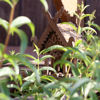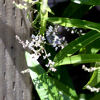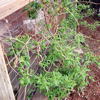Summer in the garden
 At the beginning of June, we celebrated our fifth anniversary and spent part of the weekend in Napa. One of the highlights was a stop at Hoffman Farms. As Anita has written, we picked seven pounds of green walnuts in the dappled shade of a stand of trees that pushed up from dry, level soil.
At the beginning of June, we celebrated our fifth anniversary and spent part of the weekend in Napa. One of the highlights was a stop at Hoffman Farms. As Anita has written, we picked seven pounds of green walnuts in the dappled shade of a stand of trees that pushed up from dry, level soil.
Mr. Hoffman was kind enough to tell us what to look for as we picked, and we had the pleasure of chatting with him about his farm while we visited. Being around so many growing things started me thinking about our own garden — the experiment in edible landscaping that we began shortly after we moved into Chez Moultrie.
When we bought our house, the back forty (feet, that is) was absolutely disgusting: a flea-infested dirt-pit and dog-toilet, dominated by a sterile avocado tree, a junk fruit tree, a bottlebrush tree, and a badly overgrown magnolia. The avocado was as tall as the house and leaning dangerously, the “fruit” tree produced small cherry-like things that tasted awful, and the bottlebrush was also as tall as the house and sported a canopy at least 20 feet wide. Even though we had a list of house renovation projects as long as the trees were high, we had learned our lesson from a previous series of “why didn’t we do that sooner” landscaping episodes. The backyard would be our first project.
As our guiding principle, we decided that we would only choose plants that would produce fruit or could be eaten. We had a couple of must-haves (or rather, “hope-they’ll-grows”), and we enlisted a local landscaper to help choose the rest. We started work in March 2006, and by the end of May our backyard was transformed. Just slightly over one year later — and with summer beginning — it seems like a good time to take a full tour. I’ll spread it out over a few episodes so that we don’t get too tired. Put on your grubbies, and let’s get started.
We enter the yard from the lower deck, down a couple of steps to the patio. On the left, you’ll notice our bed of lavender. If it looks a bit disheveled, it’s because I took to it vigorously with the clippers a few weeks ago. If there’s one thing that I can’t abide, it’s uppity lavender, and this pack had started acting like it owned the place. Nevertheless, it’s pretty and it smells good. Unfortunately, smelling good is about all that this particular breed is good for; I asked for lavender, but I didn’t specify the type, and our type doesn’t do so well for cooking. On the bright side, the flowers make a very pretty garnish and if we need insecticide or air freshener, we’re all set. Live and learn — and maybe rip and replace with a culinary variety next year.
Continuing along the deck fence line, we see Lazarus the Lemon Verbena. This past winter, while facing a Day of the Triffids-caliber invasion of oxalis and other assorted weedy marauders, I’m ashamed to say that I resorted to chemical defenses. Powerful chemical defenses that came in spray bottles with warnings on the back and front. Careful as I was, some of the nearby plants paid an awful price including, I thought, the verbena. Within days, every single green leaf turned brown and dropped off, leaving behind a bleached tangle of branches lashed to the fence like a skeleton in a roadside gibbet.
Crushed and guilty, I wrote it off but left it in place, lacking the time or the energy to tear it out. Lo and behold, as winter turned to spring, the small green tips of fresh leaves poked out on a few branches. Today, it swaggers with such rude health that we’ve stopped shooing the dogs away from it; as far as they’re concerned, it’s one big salad bar. Did it really die and return to life? Well…no. My adventures with weed control happened to coincide with a few frosty evenings and the leaf drop was as natural as the seasons turning. We haven’t yet made the verbena the subject of a food project, although it did play a supporting role as garnish in last week’s Le Bourget. But the plant is waving about with such vigor that it’s only a matter of time — I’m sure it could spare a few leaves so that we can try our own version of Shuna’s verbena-infused ice cream, or perhaps an infusion.
And even though the verbena was just doing what plants do, the shower of brown leaves was an accusation as penetrating as the beating of that tell-tale heart. I don’t know what I’ll do when the next rainy season animates a green army of weeds, but I’ve sworn a mighty oath to resist the lure of chemical solutions (if you’ll forgive the pun). As I write this, I’m waiting for the sun to go down so that I can retrieve the container of ladybugs currently hibernating in our downstairs refrigerator and release them in the yard: a beetle Delta Force ready to kick some aphid butt.
Next time: The Northside Fruit Preserve and the magnolia that goes both ways!









Comment by cookiecrumb
You got all that fabulosity out there in a year?
Sigh…
Posted on 06.29.07 at 12:43PM
Comment by jill
i have the same oxcalis problem. what did you use to cure it? our gardner told me that unless you sift the soil to get all the little bulbs out, it will be back the following year. Any help you can give would be greatly appreciated!
Posted on 07.03.07 at 9:21PM
Comment by Cameron
Jill: I used RoundUp, but I’m not proud of it. I’m going to try hand weeding from here on out…and put down another layer of chips to try and suffocate the little buggers. I anticipate an endless war, as two of our three yard-adjacent neighbors have let their backyards go wild.
Posted on 07.05.07 at 11:34AM